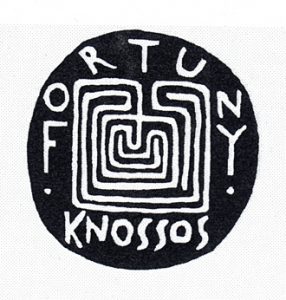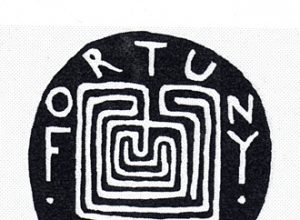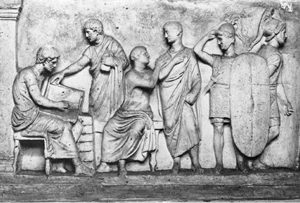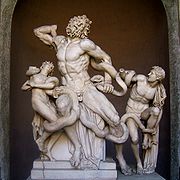
Sophie Basch is the autor of the powerful volume Rastaquarium, her recent book on the relationships between Art Nouveau and the Dreyfus Affair in Proust’s work. In this summary of her talk given to the Arts & Sociétés seminar, she identifies for us the references to primitive Greece of this writer who, without being very knowledgeable in archeology, shared the Cretomania of his time, wich was marked by the latest discoveries from the Knossos excavations in 1900. In Remembrance itself are thus to be found again the era’s aesthetic and archeological debates.
Sophie BaschMateriel Culture: Marcel Proust's Ariadne's Thread, From Pre-Hellenic Greece to Art Nouveau

1. Knossos fresco, known as “La Parisienne,” and snake goddess figurine, which inspired the costumes for Jules Bois’s play, La Furie (Les Annales politiques et littéraires, February 14, 1909).
Without being an archeology buff to the same degree Sigmund Freud was, Marcel Proust could not avoid the shock brought on by the discovery of primitive Greece and, in particular, by the Knossos excavations carried out in 1900 by Arthur Evans, which were responsible for a raging Cretomania at that time. His few allusions to Minoan civilization serve as a complement to the images of the Ballets Russes and Fortuny gowns found in Remembrance of Things Past, both of which stem from the Cretan revival. Léon Bakst, who had made a trip to Greece in 1907 and brought back a great number of sketches of Crete, was continually inspired thereby for his theater costumes and sets, and it was at a dinner at Madeleine Lemaire’s home, in 1908, that the Hispano-Venetian fashion designer, whose first logo reproduced the Minoan labyrinth, presented in France his “Knossos shawls,” which were created in Venice in 1906 and shown in Berlin in 1907 at an exhibition inaugurated by a lecture from the author of Elektra, Hugo von Hofmannsthal.

2. Greek shawls of the actress Georgette Leblanc (La Vie heureuse, March 15, 1905)
These shawls, prefigured by the pseudo-Greek drapery of Sarah Bernhardt and of Maeterlinck’s regular actress Georgette Leblanc, borrowed in particular from the catalogue of motifs reproduced in 1893 by Aloïs Riegl in the chapter about Mycenaean ornamentation in his Problems of Style: Foundations for a History of Ornament.

3. The Knossos logo of the fashion designer Mariano Fortuny, who provided the wardrobe for the Duchess of Guermantes and Albertine.
The academic world and the theatrical world were united in the same fervor: while the salon of Madeleine Lemaire, a great friend of Proust, was open to Mariano Fortuny’s Knossos shawls, the French Academy of Inscriptions and Belles Lettres invited, to two of its sessions, the author of a long, scholarly paper on pre-Hellenic costumes—Désiré Chaineux, a draftsman archeologist working at the Comédie Française—seconded by the fashion designer Jacques Doucet. The connection between Fortuny and Bakst within Proust’s work had hardly been elucidated at all before Guillermo de Osma did so: Fortuny preceded Bakst in the invention of fabrics and theatrical lighting that would influence the Ballets Russes’ director, who, in turn, led the fashion designer to introduce a bolder chromatic scale2. Despite their geographical distance, these two men belonged to the same world and crafted a shared universe.
In this context, one will hardly be surprised that the archaic Greece (in the broad, therefore vague sense) privileged by Proust was frequently associated with the theatrical world. In order to elucidate the Cretan references found in Remembrance, it would be better, however, to refer to the history of archeology and of the decorative arts than to mythology.

4. Henri Mairet, the Mycenaean throne of Sarah Bernhardt in Phèdre, 1893.
Minos and Calypso Within a Budding Grove
Remembrance is reflective, on multiple levels, of the aesthetic and archeological debates of its time. Anything but isolated, Proust’s reaction fits within a specific cultural environment. First, in Within a Budding Grove:
[D]uring the long hours which I spent in talking, eating, playing with these girls, I did not remember even that they were the same ruthless, sensual virgins whom I had seen, as in a fresco, file past between me and the sea.
Geographers, archaeologists may conduct us over Calypso’s island, may excavate the Palace of Minos. Only Calypso becomes then nothing more than a woman, Minos than a king with no semblance of divinity. Even the good and bad qualities which history teaches us to have been the attributes of those quite real personages, often differ widely from those which we had ascribed to the fabulous beings who bore the same names as they. Thus had there faded and vanished all the lovely mythology of Ocean which I had composed in those first days.3
The Panathenaic procession seen in profile makes one think of the way in which Jacques-Émile Blanche described the choreography of Afternoon of a Faun: “an archaic bas-relief, whose characters never face the audience.”4 And just beforehand, were not these girls, so similar to Greek virgins, represented in archaistic style, down to the Homeric epithets?
At that moment, as if in order that against the sea there might multiply in freedom, in the variety of its forms, all the rich decorative whole which was the lovely unfolding of the train of maidens, at once golden and rosy, baked by sun and wind, Albertine’s friends, with their shapely limbs, their supple figures, but so different one from another, came into sight in a cluster that expanded as it approached, advancing towards us, but keeping closer to the sea, along a parallel line.5
Diffracted, the frieze of modern Korai takes on color only quite later on. “Those properties used in the Russian ballet” and “the genius of a Bakst”6 alone allow one to approach them: “each of these Albertines was different, as in every fresh appearance of the dancer whose colors, form, character, are transmuted according to the innumerably varied play of a projected limelight.”7
As for Proust’s commentary on the excavations of the Palace of Minos, it might indeed have originated in an identifiable reading. Acquainted with Barrès, Proust could not have missed the controversies surrounding the sacrileges of archeology. He read Victor Bérard, who was seeking to retrace Ulysses’ voyage, as his correspondence confirms,8 and perhaps also Henri de Régnier, who shared his fascination with labyrinths and who in 1904, in Le Gaulois du dimanche, recounted his visit to Evans, in the land of King Minos.9 He no doubt noticed an article by Pierre Louÿs, written in 1901 and reprinted in 1906 when Le Voyage de Sparte came out:
Until now, the purpose and result of the patient strokes of the pickaxe into the ancient earth had been to confirm our book-learnt knowledge about the characters of which history speaks, or about their contemporaries. . . . And here we have now the excavations of Crete, which carries us off once and for all into chimerical centuries. The Palace of Minos and Pasiphaë, the labyrinthe built by Daedalus, the terrace of Icarus, the apartment of Phaedra, the monumental lair of the Minotaur have just been cleared, measured, and crossed: all mythology descends back into history.
One Thousand and One Nights reports nothing to us that testifies to a mythical imagination as rich as the one from which the Cretan legend springs. And henceforth, King Minos is stripped of his legend even more so than Charlemagne. We breathe where he lived, our steps resound upon the paving stones where his royal throne was; we have in our possession eighty inscriptions relating to his era: it is daylight. Soon, we will be able to reconstitute his countenance, his reign, his time. We will see Minos as he was: king of Knossos, enemy of Athens, and great palace builder. No doubt, the discovery is of interest initially to the historian. But the painter and the poet, on the other hand, will be able to imagine that it just as well revives the old tale so dear to their ancient masters.10
Louÿs did not hear the charge sounding against archeology in his homage to Evans. The tone of his text, formulated as a regret, remains no less melancholic. Proust’s nostalgia seems modeled on that of Louÿs.
The Guermantes and Knossos Way
The second reference to the Knossos excavations in Remembrance comes in The Guermantes Way, when Proust described the suburban village where the actress Rachel, mistress to his friend Saint-Loup, resides:
It had been a country village, and had kept its old mayor’s office sunburned and brown, in front of which, in the place of maypoles and streamers, three tall pear trees were, as though for some civic and local festival, gallantly beflagged with white satin. These villages in the environs of Paris still have at their gates parks of the seventeenth and eighteenth centuries which were the “follies” of the stewards and favourites of the great. A fruit-grower had utilised one of these which was sunk below the road for his trees, or had simply, perhaps, preserved the plan of an immense orchard of former days. Laid out in quincunxes, these pear trees, less crowded and not so far on as those that I had seen, formed great quadrilaterals—separated by low walls—of snowy blossom, on each side of which the light fell differently, so that all these airy roofless chambers seemed to belong to a Palace of the Sun, such as one might unearth in Crete or somewhere; and made one think also of the different ponds of a reservoir, or of those parts of the sea which man, for some fishery, or to plant oyster-beds, has subdivided, when one saw, varying with the orientation of the boughs, the light fall and play upon their trained arms as upon water warm with spring, and coax into unfolding here and there, gleaming amid the open, azure-panelled trellis of the branches, the foaming whiteness of a creamy, sunlit flower.11
Proust’s friends had brought the “follies” up to date. Robert de Montesquiou and Boni de Castellane each owned their “Pink Folly,” copies of the Grand Trianon, one in Le Vésinet, where a Neo-Grec temple sheltered the marble bathtub of Madame de Montespan, the other on Avenue Foch, surrounded by French formal gardens. What does the Palace of Knossos have to do with this decor?

5. Map of Knossos (Father Marie-Joseph Lagrange, La Crète ancienne, Librairie Victor Lecoffre, 1908).
The proximity between French formal gardens and the layout of Minoan palaces illuminates a parallel, which is reinforced by the importance of ornamental lakes at Versailles, the palace of the Sun King, as well as at Knossos, where the sophistication of its hydraulic system had dazzled the public. Yet, unlike Versailles, the Minoan palaces enjoyed all modern comforts: “alongside the great throne rooms and the paved plazas surrounded by tiered seating for bull races or dances, the bathrooms and all the way up to the lavatories answered all our hygienic needs.”12

6. Tirynthan fresco, or Bakst before Bakst.
Passionately fond of Versailles and of labyrinths, Proust had stayed at Versailles’s Hôtel des Réservoirs from August to December 1906 and in the Fall of 1908. The reservoirs in question make one think more of Mansart and Le Nôtre’s fountain pools than Minoan ones. At the start of the twentieth century, the “City of Water” par excellence, is the one of which Henri de Régnier, and Robert de Montesquiou in Les Perles rouges,13 came to sing. Yet in that masterpiece of reverberation, Proust’s Remembrance, the layout of Knossos, with the nested compartments of its roofless ruins, was superimposed upon white-flowered walls as well as upon Cretan frescoes. Scholarly study of Antiquity meets up here with the archeology of the present. As if in echo to the shimmering of the sea on the glass bookcases in the room of the Narrator in the Grand Hotel of a Balbec that is as far removed from Lebanon as Knossos is from Versailles, two fin-de-siècle motifs intertwine, merging with the lapping of the springtime waters on the espaliers.
Notes
1 This present text summarizes the argument developed in the article “Proust à Cnossos ou le cosmopolisme archéologique. Échos de la Grèce archaïque et reflets de la crétomanie Art nouveau dans À la recherche du temps perdu,” wich appeared in Nathalie Mauriac and Antoine Compagnon, eds, Du côté de chez Swann ou le cosmopolisme d’un roman français (Paris: Honoré Champion, 2016), p.103-30.
2 Guillermo de Osma, Fortuny et Proust. Venise, les Ballets russes (Paris: L’Échoppe, 2014), p. 47-48.
3 Marcel Proust, Within a Budding Grove, trans. C.K. Scott Moncrieff, http://www.planetbook.com/ebooks/Within-a-Budding-Grove.pdf, pp. 775-76.
4 Jacques-Émile Blanche, “L’Antiquité en 1912”, Le Figaro, May 29, 1912: 1-2.
5 Within a Budding Grove, p. 671.
6 Ibid., p. 770.
7 Ibid., p. 772.
8 “If nothing new comes up soon, I will find Nonelef exactly like twenty other people and will no longer have to struggle against this classical, blue-eyed sea Siren who is a direct descendent of Telemachus and whose traces Monsieur Bérard his rediscovered near Calypso’s island” (letter of August 10, 1902 to Antoine Bibesco, in Proust’s Correspondance, vol. 3, à. 88).
9 “Une visite au labyrinthe”, Le Gaulois du dimanche, July 9-10, 1904, reprinted in Sujets et paysages (Paris: Mercure de France, 1923), pp. 76-84.
10 Pierre Louÿs, “L’île mystérieuse” (1901), in Archipel, (Paris: Fasquelle, 1906) pp. 21-25.
11 Marcel Proust, The Guermantes Way, trans. C.K. Scott Moncrieff http://uberty.org/wp-content/uploads/2015/Proust-3.pdf, p. 101.
12 Adolphe Reinach, “Les peuples de la mer et l’apparition des Hellènes. Les migrations des Achéo-Éoliens en Grèce, dans les Îles et en Asie et les bases historiques de l’Iliade”, in L’Hellénisation du monde antique. Leçons faites à l’École des Hautes Études Sociales (Paris: Félix Alcan, 1914), p. 5.
13 Luc Fraisse, “Mémoire et imaginaire de Versailles dans les écrits de Proust”, in Véronique Léonard-Roques, eds, Versailles dans la littérature. Mémoire et imaginaire aux XIXe et XXe siècles (Clermont-Ferrand: Presses universitaires Blaise Pascal, 2005), p. 231-52.
Bibliography
BOUCHER, Anaïs . Ed. La Grèce des origines, entre rêve et archéologie. Paris: Réunion des Musées Nationaux, 2014.
CALOI, Ilaria. Modernità minoica. L’arte egea e l’Art nouveau. Il caso di Mariano Fortuny y Madrazo. Florence: Firenze University Press, 2011.
FARNOUX, Alexandre. Cnossos, l’archéologie d’un rêve. Paris: Gallimard, 1993.
_____. “Art minoen et Art nouveau. Le Miroir de Minos.” In Antiquités imaginaires. Alexandre Farnoux, Philippe Hoffmann, and Paul-Louis Rinuy. Eds. Paris: Presses de l’École Normale Supérieure, 1996.
GERE, Cathy. Knossos and the Prophets of Modernism. Chicago and London: The University of Chicago Press, 2009.
MOMIGLIOANO, Nicoletta. “Modern Dance and the Seduction of Minoan Crete.” In Silke Knippschild and Maria Garcia Morcillo. Eds. Seduction and Power: Antiquity in the Visual and Performing Arts. London: Bloomsbury Publishing, 2013.
RIEGL, Aloïs. Problems of Style: Foundations for a History of Ornament. 1893. Trans. Evelyn Kain. Princeton: Princeton University, 1992.
POTIN, Yann. “Les archives et la matérialité différée du pouvoir. Titres, écrins ou substituts de la souveraineté?” Pouvoirs, 153 (2015): p. 5-21.
ZIOLKOWSKI, Theodore. Minos and the Moderns: Cretan Myth in Twentieth-Century Literature and Art. Oxford, England and New York: Oxford University Press, 2008.



